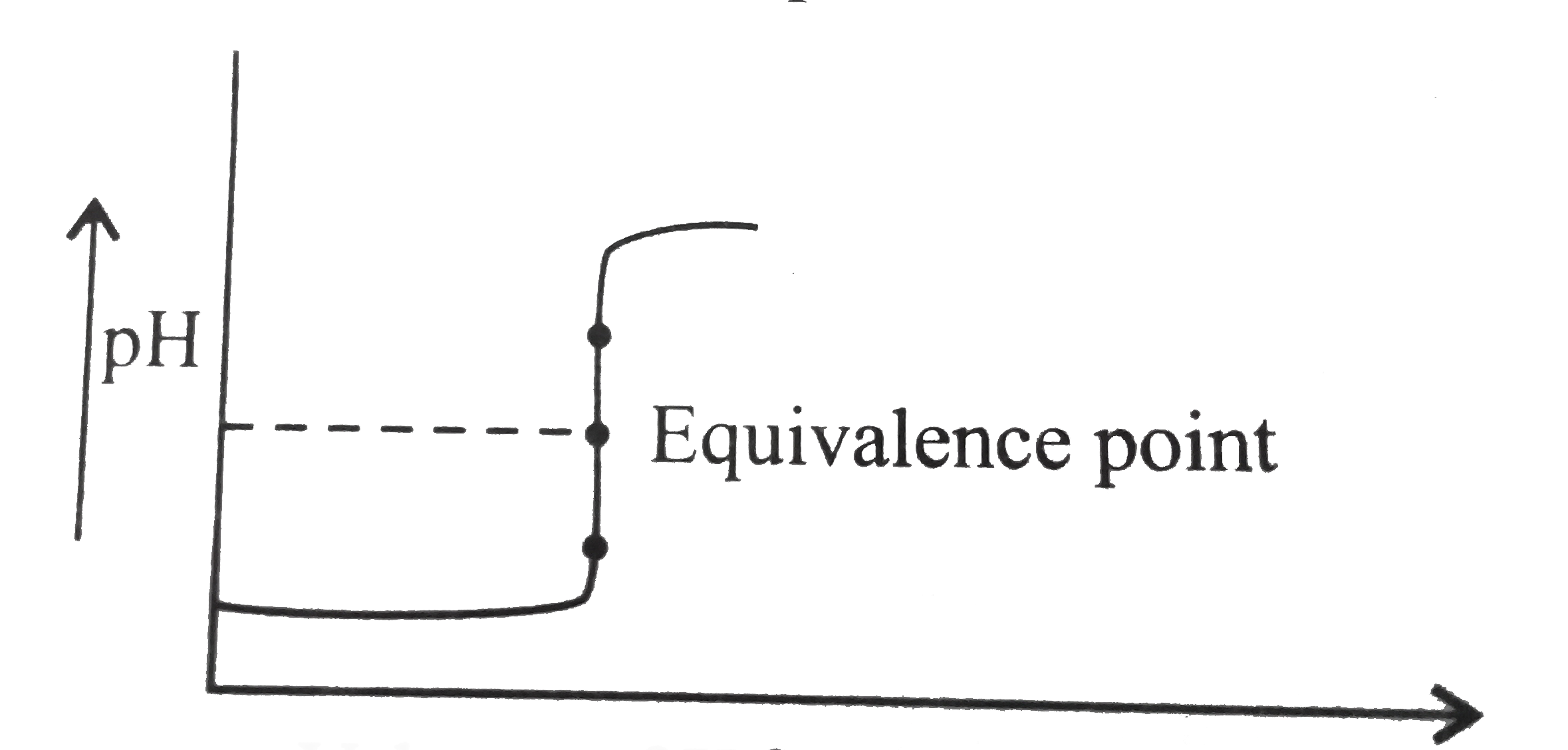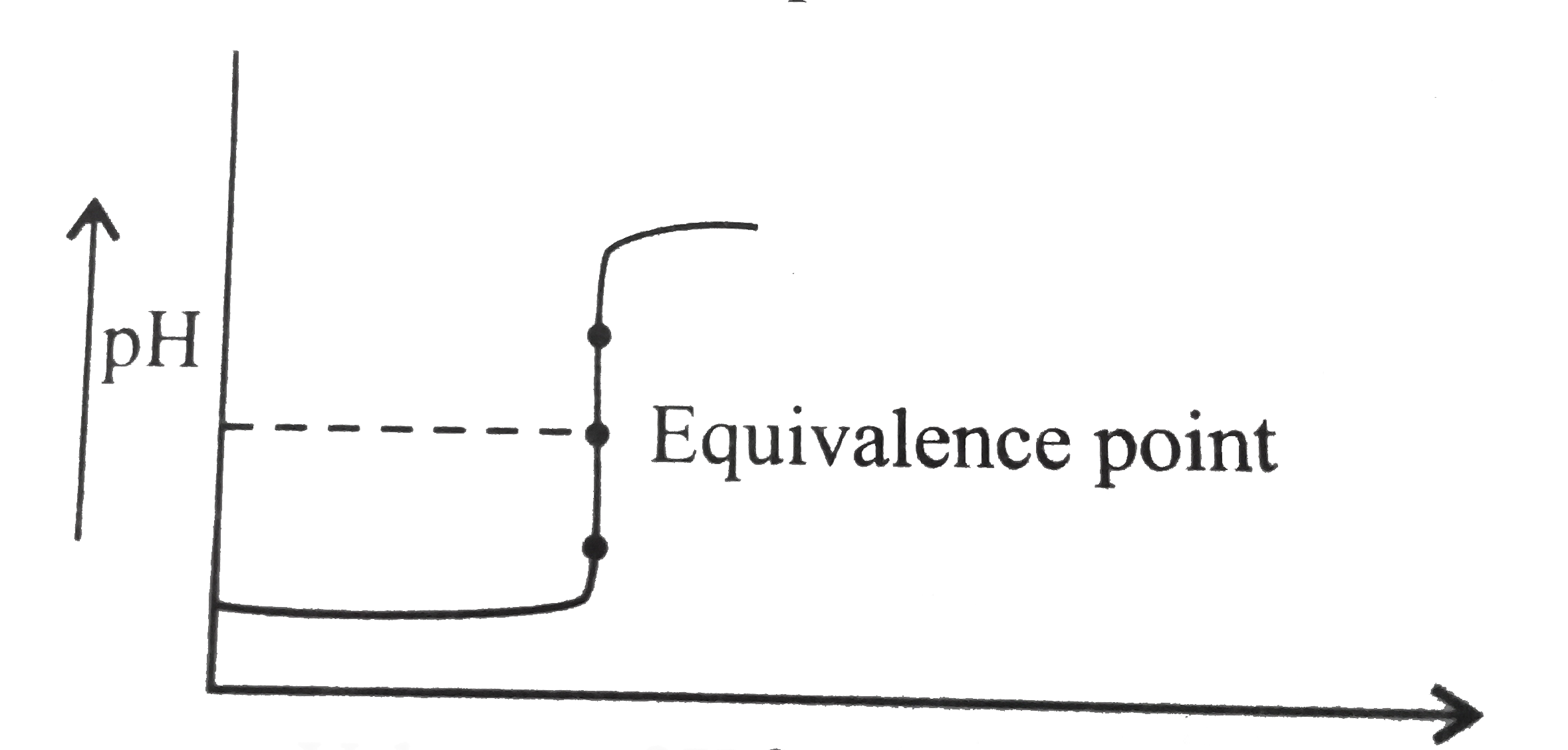A strong acid is titrated with weak base. At equivalence point, pH will be :
<7
>7
0
Cannot predict
The correct Answer is:A
To determine the pH at the equivalence point when a strong acid is titrated with a weak base, we can follow these steps:
Step 1: Understand the nature of the reactants
- A strong acid completely dissociates in solution to produce a high concentration of hydrogen ions (H⁺).
- A weak base only partially dissociates in solution, producing a lower concentration of hydroxide ions (OH⁻).
Step 2: Identify the pH of the strong acid
- The pH of a strong acid is typically less than 3 or 4 due to the high concentration of H⁺ ions.
Step 3: Consider the reaction at the equivalence point
- At the equivalence point, all the strong acid has reacted with the weak base. The resulting solution will contain the conjugate acid of the weak base.
- This conjugate acid will partially dissociate in water, producing H⁺ ions.
Step 4: Determine the pH at the equivalence point
- Since the solution contains a conjugate acid from the weak base, it will contribute to an increase in H⁺ concentration.
- Therefore, the pH at the equivalence point will be less than 7 because the solution remains acidic due to the presence of the strong acid and the conjugate acid.
Conclusion
- The pH at the equivalence point when titrating a strong acid with a weak base will be less than 7.
Final Answer
The pH at the equivalence point will be less than 7.
---
- A strong acid completely dissociates in solution to produce a high concentration of hydrogen ions (H⁺).
- A weak base only partially dissociates in solution, producing a lower concentration of hydroxide ions (OH⁻).
- The pH of a strong acid is typically less than 3 or 4 due to the high concentration of H⁺ ions.
- At the equivalence point, all the strong acid has reacted with the weak base. The resulting solution will contain the conjugate acid of the weak base.
- This conjugate acid will partially dissociate in water, producing H⁺ ions.
- Since the solution contains a conjugate acid from the weak base, it will contribute to an increase in H⁺ concentration.
- Therefore, the pH at the equivalence point will be less than 7 because the solution remains acidic due to the presence of the strong acid and the conjugate acid.
- The pH at the equivalence point when titrating a strong acid with a weak base will be less than 7.
The pH at the equivalence point will be less than 7.
Topper's Solved these Questions
- BOOK - VMC MODULES ENGLISHCHAPTER - IONIC EQUILIBRIUMEXERCISE - LEVEL 250videos
IONIC EQUILIBRIUM
- BOOK - VMC MODULES ENGLISHCHAPTER - IONIC EQUILIBRIUMEXERCISE - LEVEL 2 NUMERICAL VALUE TYPE15videos
IONIC EQUILIBRIUM
- BOOK - VMC MODULES ENGLISHCHAPTER - IONIC EQUILIBRIUMEXERCISE - IN - CHAPTER EXERCISE - K10videos
IONIC EQUILIBRIUM
- BOOK - VMC MODULES ENGLISHCHAPTER - INTRODUCTION TO ORGANIC CHEMISTRY EXERCISE - JEE ADVANCED ARCHIVE81videos
INTRODUCTION TO ORGANIC CHEMISTRY
- BOOK - VMC MODULES ENGLISHCHAPTER - JEE MAIN - 5EXERCISE - PART II : CHEMISTRY (SECTION - 2)5videos
JEE MAIN - 5
Similar Questions
A weak base MOH was titrated against a strong acid. The pH at 14 th equivalence point was 9.3. What will be the pH at 34 th equivalence point in the same titration? (log3=0.48)
View Solution(a). IF both (A) and (R) are correct and (R) is the correct explanation of (A).
(b). If both (A) and (R) are correct but (R) is not the correct explanation of (A).
(c). If (A) is correct, but (R) is incorrect.
(d). If (A) is incorrect, but (R) is correct. ltbr> (e) if both (A) and (R) are incorrect.
Q. Assertion (A): In the titration of strong acid and strong base, phenolphthalein is used as suitable indocator.
Reason (R): IN the titration of strong acid and strong base, the equivalence points lies is the pH range of (3.0−10.5) and phenolphthalein have pH range of (8.0−9.8).View SolutionA weak base (BOH) with Kb=10−5 is titrated with a strong acid (HCl), At 3/4 th of the equivalence point, pH of the solution is:
View SolutionThe extent to which hydrolysis proceeds is expressed as degree of hydrolysis and is defined as fraction of ne mole of the salt that is hydrolysed when equilibrium has been attained . The nature of solution also depends upon the extent upto which the salt has been hydrolysed . Degree of hydrolysis of a salt ofdepends upon concentration of salt at a particular temperature and varies inversely . Consequently , nature of the solution whether acidic or alkaline can be determined . pH of the solution of salt of weak acid and strong base or weak base and strong acid depends upon its concentration . So by varying the concentration of salts their pH could be adjusted .
For strong base and weak acid litration , the [H3O+] at equivalence point will beView SolutionSTATEMENT-1: Autoprotolysis constant of water increases with the increase in temperature.
STATEMENT-2: When a solution of a weak monobasic acid is titrated wita a strong base, at half neutralization point pH=pKa+1.
STATEMENT-3: The pH of 10−8 m HCl is 8.View SolutionAssertion : In a titration of weak monoprotic acid with strong base, the pH at the half equivalence point is pKa.
Reason : At half equivalence point, it will form acidic buffer at its maximum capacity where [acid]=[salt].View SolutionIn which of the following acid-base titration, the pH is greater than 8 at the equivalence point ?
View SolutionIn acid-base titration react rapidly to neutralise each other. Equivalence point is a point at which the acid and the base (or oxidising agent and reducing agent) have beem added in equivalent quantities. The end point in the point at which the titration stops. since the purpose of the indicator is to stop the titration close to the point at which the acid and base were added in equivalent quantities, it is important that the equivalent point and the end point be as close as must change colour at a pH close to that of a solution of the salt of the acid base. Singificantly, the pH changes most rapidly near the equivalent point. The exact shape of a titration curve depends on Ka and Kb of acid and base.

The pH at equivalence point isView SolutionAn acid-base titration consists of the controlled addition of a dissolved base to a dissolved acid (or the reverse). Acid and base react rapidly to neutralize each other. At the equivalence point, equivalents of reacting substances are equal. The pH during a titration changes every time with a drop of titrant added, but the rate of this change varies enormously. A titration curve, graph of pH as a function of the volume of titrant, displays in detail how the pH changes over the course of an acid base titration. Significantly. the pH changes most rapidly near the equivalence point. The exact shape of a titration curve depends on the KaandKb of acid and base
The pH at equivalence point is:View SolutionIn acid-base titration react rapidly to neutralise each other. Equivalence point is a point at which the acid and the base (or oxidising agent and reducing agent) have beem added in equivalent quantities. The end point in the point at which the titration stops. since the purpose of the indicator is to stop the titration close to the point at which the acid and base were added in equivalent quantities, it is important that the equivalent point and the end point be as close as must change colour at a pH close to that of a solution of the salt of the acid base. Singificantly, the pH changes most rapidly near the equivalent point. The exact shape of a titration curve depends on Ka and Kb of acid and base.

The curve represents the titration ofView Solution

